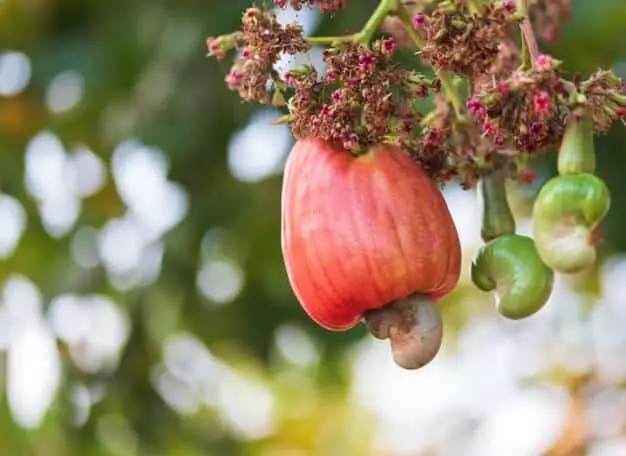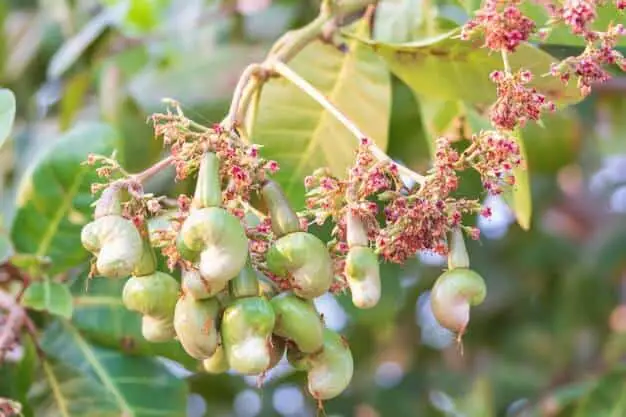Contents
Cashews are best known for the healthy nuts they produce and their fragrant false fruit, the cashew apple. Both parts are edible and rich in various vitamins and nutrients. If for these reasons you’re considering growing them in your garden. You should know that cashew trees can be grown using any of these three methods; air layering, from its seeds, and grafting. In this article, I’ll discuss only two of these methods, the seeds method, and the air-layering method. But first, let’s get to know cashews a little.
 Source : Image
Source : Image
Cashew Basics
Origins: Cashew trees are native to Brazil and the Caribbean Islands but they are now grown worldwide. You’ll find them in Africa and Asia. It yields an edible false fruit that is shaped like a bell pepper but the main fruit is attached to the fake fruit.
Method of Propagation: Cashews can be propagated using their seeds, through air-layering, or through grafting.
Planting Season: Air layering is usually done in the months of February and March so they can be planted in the months of June and July.
Fruit Growth Period: It takes a cashew tree planted from seedling three years to bear fruit and those grown from grafting eighteen months to yield fruit.
USDA Hardiness Zone: Cashew trees grow in USDA zones 10 and 11.
Planting Soil: Sandy or sandy-loamy soils are the best for growing cashew trees.
Ideal pH Planting Levels: Cashew trees are best grown in soils with pH levels ranging between 5.0 and 6.5.
Exposure to Sunlight: Cashews grow under partial to full exposure to sunlight.
Growing a Cashew Tree from its Seeds
 Source : Image
Source : Image
To grow a cashew tree from its seeds you’ll need the following:
- Fresh cashew seeds.
- Planting pots
- General-purpose potting compost
- Vermiculite
Selecting the Seeds
When panting cashew trees from seeds, it is best to go for fresh seeds. By fresh, I mean that the seeds shouldn’t be more than three months old, else they may not germinate. The seed is basically the nut that lies within the kernel.
Prepping to Plant
Your ideal planting pot should be one that drains well. Simply fill it about three-fourths of its height with a mixture of fresh compost and vermiculite. Vermiculite is simply minerals added to the soil to help accelerate the growth of plants. A handful of Espoma’s organic vermiculite mixed in with Black Gold’s all-purpose potting mix will work great.
Planting the Seeds
Now, it’s time to plant the seeds. Cashew seeds are first planted in pots because it’s easier to give them the critical care that they need to grow.
Plant the cashew seeds at an angle at a depth of 5cm to 10cm deep. You can choose to plant each seed in an individual pot or a group of them in a large planting pot. I prefer the latter method because only the strong seeds will survive. Thus, leaving you with seeds that are bound to flourish into full-grown cashew trees.
Once this has been done, cover the seeds with soil and water them. Be careful not to overwater them else they’ll be susceptible to fungal infections.
You’ll notice the seeds beginning to germinate in a matter of days or weeks. Don’t forget to place the pot in a location where the seeds will be partially exposed to sunlight. Avoid full exposure to sunlight as much as you can.
Transplanting your Seedlings
Once your seedlings have begun outgrowing their planting pot, it is time to transfer them to your garden. Clear out all the weeds and prep your soil for planting. Well-drained soils such as sandy-loamy or sandy soils are the best fit for cashew trees. If your garden is filled with clay soil, then it is not suitable for growing cashews. This is because it easily gets waterlogged which will, in turn, expose the cashew tree to fungal infections such as root rot.
Dig a hole that’s large enough to fit the base of the seedling. Plant the seedling into this hole and cover it up with soil. Ensure that you’ve got at least 10m spacing on all sides between cashew seedlings because they’ll eventually develop an extensive root system. Once you’re done planting, don’t forget to water your plants.
Growing a Cashew Tree through Air-layering
Air layering is a propagation method that occurs frequently in nature. It involves low-hanging branches that come in contact with the ground developing solid roots over time. This propagation method yields a new plant that matches the genetic detail of its parent plant by 100%. This means that the new plant is an exact replica of the parent plant.
Cashew is a highly cross-pollinated crop. This means that newly planted crops will vary in many ways from their parent plant. So if you want an exact replica or better chances of survival, you need to go through the air-layering route.
To do this you’ll need:
- A Sharp Knife
- A Toothpick
- Rooting Hormone (Preferably IBA)
- Sphagnum Peat Moss
- Polyethylene Film
- String
Using your sharp knife, cut out a ring of bark that is about 0.8cm thick along the aerial branch you wish to use. The cut should be about 1 inch long upwards and towards the center of the stem without injuring the underlying wood.
Use your toothpick to keep the cut open as the new roots will develop from it. Apply the IBA rooting hormone to the cutting.
Cover the cutting using the sphagnum peat moss and secure it in place by wrapping polyethylene film over it. Secure the fil with the string.
After 40 – 60 days, new roots should have developed. Wait two weeks longer before separating the new shoot from the parent plant.
Go ahead and plant it in your garden.
Using either of the two methods listed above, you’ll be guaranteed to have cashew trees growing in your garden. Good luck.
Want to know more about gardening ?
Fill in your email address in the form below and you'll receive all the latest updates directly in your in-box.
Thank you for subscribing.
Something went wrong.